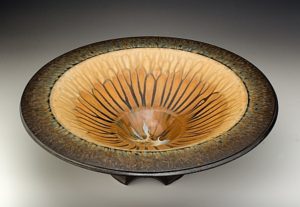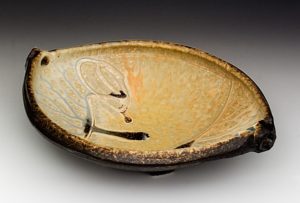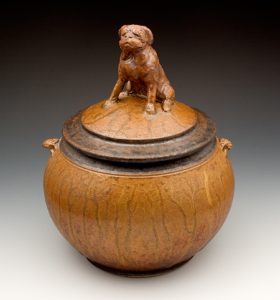 Studio Pottery: Finding a Balance
Studio Pottery: Finding a Balance
In conjunction with the opening of “Studio Potter,” an exhibition held at the Vermont State Craft Center at Frog Hollow, Middlebury, featuring 11 full-time potters from across the United States, exhibitor Cynthia Bringle participated in a panel discussion on “Finding a Balance: Practical Productivity and Personal Creativity.” The following article is condensed from her statement and responses to audience questions. For further information about this potter, see the CM Portfolio, “Cynthia Bringle” in the December 1974 issue. –Editor
I call myself a production potter. That only means that I produce to make a living. I don’t produce repeatable items as in one design for a pitcher. If I sit down and make 12 pitchers, I’ve made 12 different ones. I’ve always worked that way. I’ve never produced a catalogue or put out a price sheet that said, “It’s blue on the bottom and white on the top.” But there’s nothing wrong with that; everyone has to choose a way to work. There’s no wrong or right way. It has to be what’s right for you. For me the balance comes in that I work in so many different ways—I do raku, stoneware and porcelain. The diversity in that creates growth in me.
I began making pots full time in 1965. I can’t say that I really made a living the first year, but I didn’t go under. I simply decided to set up a studio, start small and just keep doing it. It didn’t occur to me to worry about “What if this happens? What if that happens?” You can’t if you’re going to be a studio potter.
I started out with very little equipment. I had a wheel, built a kiln and got a gram scale, but didn’t have a clay mixer. Now I’ve got all the necessary equipment and a huge building. It wasn’t that way in the beginning. I rented space for ten years before building a 30 x 50 foot studio in the middle of the woods in the mountains near Penland School in North Carolina. Having rented for that long, I sort of knew what I wanted. To figure out how large the studio should be, I measured all the space then in use and added to it. I planned a studio large enough for my work and for someone else’s if I wanted to have an apprentice or a friend there. I’ve often had other potters come in and work for a month or whatever. But when there’s no one else in the studio, I manage to fill it up. Anyone who has a studio knows that no matter what amount of space you have, you can always manage to fill it. So for me it’s a luxurious space.
I often teach workshops at Penland and other places, but that’s not a major part of my income. A studio potter mostly loses money doing something like that. You can make more money staying home and making pots because you spend so much time away. And the down time before you go away is significant. You’ve got to crank down all you’re doing and get started up again when you get home.
I’m not very good at the business part of making pots for a living. My desk is always the last place I get to. In the beginning, I always figured that if I could pay the bills and have a little money left over, I was  making it. I don’t keep good accounts. In talking to Paul Soldner on time, he said, “ My accountant finally gave up on me and told me to write a check for everything an keep it that way.” So that’s the way I do it.
making it. I don’t keep good accounts. In talking to Paul Soldner on time, he said, “ My accountant finally gave up on me and told me to write a check for everything an keep it that way.” So that’s the way I do it.
As for new ideas, every time I work on something, whether it’s raku or stoneware, I can look at it and see what else I want to do. Sometimes a customer will come in and say, “Well, have you ever done this?” That sort of challenge brings out new ideas for pots that you wouldn’t have done before. If I do a dinnerware order, the people come in and I find out their preferences in terms of colors and style by having them look around the showroom and say what they like, what they don’t like. If I do something like lamp bases, I might have them send me color swatches of upholstery. You can’t ignore the client.
I like doing orders, but I certainly wouldn’t like it if all my work were done that way. Only a small portion is orders for people. They are challenging, but they are also very time consuming. It probably takes three times as long to do an order for someone as it does to just sit down and make some pots. There’s all that thought that goes behind an order, plus making extras to make sure you have enough.
I don’t worry about being creative. I worry about the object, whether it says something. I don’t care whether it’s a mug, a  porcelain bowl or a raku pot. Either it’s good or it’s not good.
porcelain bowl or a raku pot. Either it’s good or it’s not good.
You never quit learning when making pots. The lessons go on and on. When teaching, I often say, “Listen, the only reason I can tell you all of this stuff is that I’ve already done it all wrong about ten times.” You continue to learn. If you knew it all, you’d quit. Or if you think you know it all, then it’s time to quit.
Every time a kiln load of pots comes out, I think, “Okay, that’s okay for now. But I want to be somewhere else as far as the next kiln load goes.”
Outlooks
Participants in the Vermont “Studio Potter” show were asked to describe where they live and resulting environmental influences, their lifestyles, studios and concerns about their work.
Richard Aerni, Cincinnati
Living in the Midwest in general tends to keep my work along solid functional lines. And living in my neighborhood in particular, where the buildings were erected a century and a half ago by German-born builders, tends to make me appreciate and want to emulate the considerable craftsmanship in their work. Our house is a brick duplex, which we are in the process of rehabilitating. The studio occupies the other half of the building. We share a common courtyard in the back with my partner Michael Frasca, his wife and children. Depending on my mood, I either see a hopelessly rundown neighborhood, lacking the money, people and inspiration to rebuild it; or else a rather charming old area, gracefully aging, echoing with life and with a personality you just couldn’t  find anywhere else.
find anywhere else.
All our pots are produced collaboratively. Our work is mostly thrown in sections, joined on the wheel, then rethrown. We may work on a piece four or five times over the course of two days. The clay is a relatively simple stoneware we mix ourselves from mostly regional clays, although we have been experimenting with other bodies, looking for more durability and a lighter fired color. Most pots are wood ash glazed and single fired in a downdraft, natural gas kiln to cone 9-10. Much of the glazing is done in a spray booth, since the size of the pots precludes dipping. We also fire a fair amount of copper-red pieces and have a bit of fun trying to see how big a pot we can get to go red.
Craftsmanship is the prime concern, though there are a multitude of others. I like graceful forms, so classical shapes tend to prevail, and I have a deep and abiding respect for the functional pot. I’m also interested in using raw materials to produce a variety of effects. I like to think that the pots we make have a quiet feel to them, that they’ll fit gracefully into their surroundings.
Michael Frasca, Cincinnati
There are no one-story buildings in our neighborhood; one is dwarfed by multiple story structures that rise out of the sidewalk and stretch for entire blocks without pause in the façade. I suppose I have always had the desire to make pots that fit the scale of this environment and become as much a part of it as the Italianate cornices and decorative cast-iron storefronts. My home is a three story, Federal-style, of brick, appearing neatly stacked from the outside but rather shabby on the inside. We live on the third floor while the first and second floors are slowly rejuvenated. Our studio was a cold, vacant, condemned pile of bricks, this one not so neatly stacked even on the outside. Renovation of the studio has been a slow and  tedious project.
tedious project.
Presently one of our major concerns is making sure that pots can be shipped at affordable prices. Shipping cost can scare off a prospective buyer faster than any other consideration. We have devised a packing system that works, and often use that as a point of reference when designing new work.
Frank Boyden, Otis, Oregon
We live where we do in the middle of a preserved estuary and by the ocean because it is an amazingly rich place in terms of what we see and hear (and don’t hear). We are surrounded by silence and constant change of tide and water. This environment has affected my work greatly; I constantly use images from it.
The house and studio is a 5000-square foot barn; about 3000 square feet harbors a welding and metal area plus extensive clay space. Also attached is an 800 square foot kiln shed with a salt kiln and a reduction kiln. My raku work is fired electrically. I use extremely simple clay bodies and a lot of native materials. I use a great deal of terra sigillata, and work with polychrome terra sigillata fired in a salt atmosphere. I have recently been working with Cone 5 reduction-fired porcelain and stoneware.
A great deal of my work is done in response to things I see or come across. I work cyclically with the things that happen in the estuary—the salmon runs, returning birds, etc.
Tom and Elaine Coleman, Canby, Oregon
Tired of the city life (in Portland) and close surroundings, we moved to a Victorian farmhouse, build in 1894 on the Old Oregon Trail. This gave us more room to grow as a family and as artists. The rolling farmland lets us have a closer look at the nature we use a decoration on our pots. The original part of our studio was a cow shed; side rooms were added in the 1930s. Five years ago we build a kiln building and additional studio space. We work with a high-fire porcelain that we mix ourselves and fire in two kilns. One is a 75 cubic foot downdraft car kiln; the other is a 20 cubic foot downdraft kiln that we use mainly for testing and for firing large platters. Our concern is craftsmanship, both physical and visual.
John Glick, Farmington, Michigan
I settled in Farmington because I grew up in the area; as it turned out, thre is a good, solid, supportive community here. We live in a 130-year-old farmhouse. Recently I rebuilt the studio, and now have a 1600 square foot barnlike structure and an attached kiln building with a 100 cubic foot gas kiln.
I do about 75% thrown, 25% handbuilt ware, using a typical stoneware body, a porcelain, some ovenware clays and about 20 different glazes. Much of my work is decorated with slips during the wet working stages.
Evolution of ideas guides my work more than what people ask for in my showroom. I would rather enjoy what I make entirely for itself than give up my freedom.
Randy J. Johnston, River Falls, Wisconsin
I live about 55 miles from Minneapolis amid rolling hills and woods, where I can fire my large wood-burning kiln without complaints. We have an old and new house, an 18 x 24 foot log showroom, a 30 x 18 foot studio and a 42 x 30 foot kiln building on 24 acres of land. The studio is equipped with two Japanese kick wheels and a Leach treadle wheel. My clay body is composed primarily of Missouri fireclay, feldspar and extrafine grog. Glazes and slips are simple and chosen to complement clay body and firing. The two-chambered climbing kiln (the first chamber is approximately 180 cubic feet; the second, for salt, approximately 100 cubic feet) is fired with wood in 22 to 30 hours.
I hope to create pots that will speak to the users about the ideas that excite me. These ideas are expressed through form, gesture, colors and surfaces.
Jenny Lind, LaCienega, New Mexico
Our home is a 200 year old adobe house that has been converted to solar heat, located 20 minutes south of Santa Fe in a picturesque old farming community. My studio is also adobe and solar heated. When I look out the windows I see a field of grass, the barn and a row of cottonwood trees bordering a stream. Behind the trees are red hills dotted with little juniper pines. Sometimes my geese come down and graze in the fields, and I often watch the horses running. A large and very old juniper with beehives underneath is in the middle of the field.
I usually work with porcelain decorated with drawings and fired to cone 10 reduction in a 17 cubic foot kiln, although from time to time I use an electric kiln for brighter colors. After the glaze firing for oxide and stain decoration, there is often a second and even third firing for lusters and china paints.
My primary concern is that a piece functions, if that is it’s intention. I don’t emphasize form over function or vice versa.
Todd Piker, Cornwall Bridge, Connecticut
After training with Michael Cardew and Svend Bayer, I set up Cornwall Bridge Pottery in a renovated barn in 1974. My ware is thrown (larger pots are coiled and thrown), then single fired in a Sino-Korean, tubular wood-burning kiln and lightly salted.
Dave Shaner, Bigfork, Montana
Although I am a transplanted easterner, I love the West. I appreciate the openness of the people here. We live in a rural setting in Flathead Valley near Glacier National Park in northwest Montana. The land overlooks a pine forest into the Swan Mountains and wilderness areas. There are many lakes and streams. Our air and water are clean.
We built our studio and home; studio first. My work is divided between thrown and handbuilt, functional and nonfunctional, and is fired in a propane or wood-burning kiln.
I am concerned about my own and the world environment. Ultimately this leads to the nuclear dilemma we face.
